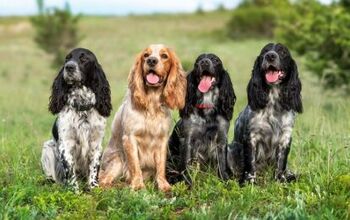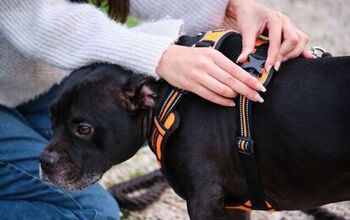Field Spaniel


About Field Spaniel
With a nickname like Fieldie, there’s no doubt that the Field Spaniel is a bird hunter’s dream. His agility and determination in the marsh as well as his ability to lure birds closer to the hunter’s blind make him a desirable hunting buddy. Although he has great flushing skills, the Field Spaniel is affectionate, loving and playful. His gentleness, patience and energy level make him a reliable playmate for kids of all ages. The Fieldie’s spunk and antics will keep the family entertained for hours.
Field Spaniels connect so strongly with their families that when it comes time to leave the dog, problems can arise. Separation anxiety is often an issue with Fieldies so he would do best with a stay at home parent or retired person. For more information on the Field Spaniel, please continue reading.
With a nickname like Fieldie, there’s no doubt that the Field Spaniel is a bird hunter’s dream.
Originating in England during the 1800s, the Field Spaniel was a favorite of bird hunters. His ability to zigzag through the dense brush and flush out prey was highly prized. Not only was he used as a tool for putting food on the table, the Field Spaniel was also a cherished companion for the hunter’s family. Today, they are rarely used for hunting but the breed has acclimated quite well to living life as a companion.
In the 1800s, there was no clear classification defining the difference between Field Spaniels and Cocker Spaniels before maturity. Back then, a Cocker Spaniel was an adult weighing less than 25 pounds while a Field Spaniel was an adult over 25 pounds. The pedigree of the parents was not taken into consideration which led to owners not knowing what breed they had until the puppy matured. In 1901, the distinction between the breeds was determined by the parent’s ancestry.
After some poor choices regarding the addition of other breeds into the bloodlines, the Field Spaniels popularity dwindled. It became way too long, had too much coat and an oddly large head. The Fieldie simply was not pleasant to look at, nor could it flush prey as well. Mortimer Smith, an English gentleman returned the breed to its original appearance and structure.
In 1909, a devastating fire swept through a kennel harboring the most of the Field Spaniels in the United States. From 1931 through 1967, there were no registrations of Field Spaniels with the American Kennel Club. Since that time, more Fieldies were imported to the U.S. Although not one of the most popular breeds, the Field Spaniel has a dedicated following of his own.
It’s best to feed the Field Spaniel a diet of high-quality, dry kibble specifically formulated for his activity level. Of course, a Fieldie who is out hunting all day will require more food than the dog that is less active.
Although the Field Spaniel has an independent streak, he is relatively easy to train.
Although the Field Spaniel has an independent streak, he is relatively easy to train. Fieldies tend to bore easily during training so the sessions should be short but repetitive. This breed does not respond to harsh treatment or being manhandled. Patience and gentleness go a long way while training the Field Spaniel. Naturally, treats provide great motivation during training sessions.
Field Spaniels enjoy competing in dog sports such as hunting tests, obedience trials, agility courses and the breed ring. Because of their affection for people, Fieldies can make effective therapy dogs.
The Field Spaniel should weigh between 37 and 45 pounds and stand between 17 and 18 inches tall at the shoulder.
The Field Spaniel has an incredibly steady temperament. He is loving and affectionate with his family and treats newcomers as if he’s known them forever. Because of his great temperament and his incredible energy, the Field Spaniel is a great companion for families who live active lifestyles. He is reliable and patient with children making him a lifelong playmate. This breed becomes easily attached to his humans and does not like being away from them. Separation anxiety can prove to be an issue for families who are working or at school all day.
Fieldies tend to bark at everything they see or hear. This is often a problem with neighbors so it is essential that the dog understand the “quiet” command. Field Spaniels also enjoy chewing things up. Toys and chewies should be made available at all times to dissuade the dog from chewing apart your belongings.
Allergies and ear problems occur quite often in the breed as do eye problems including cataracts, Ectropion and progressive retinal atrophy. Epilepsy, cancer and hypothyroidism have been diagnosed in Field Spaniels. Although rare in most medium sized dog breeds, hip dysplasia has been found in the Fieldie.
On the average, Field Spaniels live to be between 12 and 14 years old.
A complete bundle of energy, the Field Spaniel needs about an hour of exercise daily. Playing in a large, fenced yard is one of the best ways for a Fieldie to stretch his legs and run freely however; hiking in the woods or jogging through the neighborhood will also suffice. Field Spaniels love the water. With access to a pond, lake or stream, the Fieldie will frolic for hours, providing his family with laughter at his funny antics.
Fieldies enjoy playing fetch and chasing balls. Children gravitate toward him because he is as energetic and playful as they are. The Field Spaniel makes a great pet for families who truly lead active lifestyles.
The Field Spaniel has an incredibly steady temperament.
The American Kennel Club writes: “Known for its level-headedness and perseverance, the Field Spaniel is a medium-sized flushing spaniel, built for activity and endurance in heavy cover and water. One of the rarest spaniel breeds (they nearly went extinct!); the Field possesses moderately long, pendulous ears and a single coat that is both dense and water-repellent. He can be black, liver or golden liver in color; tan points or white markings are acceptable.” The Field Spaniel was accepted in the AKC’s Sporting Group in 1894.
The Field Spaniel’s coat is between medium and long in length. It’s water repellent to keep him dry and comfortable while working in the water and marsh. The coat can be wavy or it can be straight, either is acceptable. The chest, undercarriage, legs and rear area should have moderate feathering. The Fieldie’s coat can be black, roan or liver in color. Tan points or white on the chest and throat area can also occur in the breed.
Grooming a Field Spaniel is a snap. All this breed needs is a weekly brushing to remove loose coat and ensure that the feathering isn’t snarled or matted. Bathing should only be done when he gets dirty or malodorous.
Field Spaniel puppies should be introduced to as many things and people from the start. He should also attend puppy kindergarten classes to get the basics of training. Crate training is the easiest way to housetrain a Fieldie puppy.

Amy Tokic, Editor of PetGuide.com, is a passionate animal lover and proud pet parent of Oscar, a Shih Tzu/Chihuahua cross, and Zed, a Japanese Chin. Her love of animals began in kindergarten, when she brought her stuffed dog Snoopy into class with her every day. Now, she writes about her adventures in pet ownership and tirelessly researches products, news and health related issues she can share with other animal enthusiasts. In her free time, Amy loves perusing used book and record stores, obsessing over the latest pet products available and chasing squirrels with wild abandon (a habit attributed to spending too much time with her pooches).
More by Amy Tokic

























